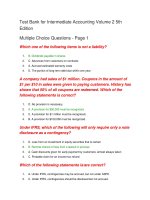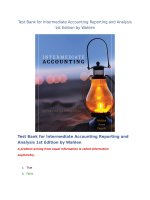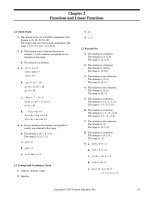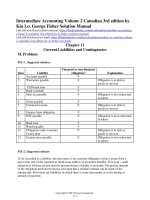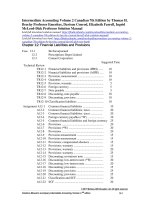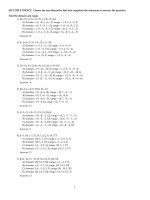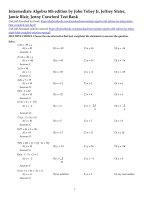Intermediate accounting volume 2 canadian 7th edition by beechy conrod farrell dick test bank
Bạn đang xem bản rút gọn của tài liệu. Xem và tải ngay bản đầy đủ của tài liệu tại đây (624.2 KB, 18 trang )
Intermediate Accounting Volume 2 Canadian 7th Edition by Thomas H. Beechy
Professor Emeritus, Davison Conrod, Elizabeth Farrell, Ingrid McLeod-Dick
Professor Test Bank
Link full download test bank: />Link full download solution manual: />MULTIPLE CHOICE. Choose the one alternative that best completes the statement or answers the question.
1) Conceptually,
liabilities constitute a present obligation as a result of a past event and entail
an expected future sacrifice of assets or services.
A) True
B) False
Answer: B
2) Under ASPE,
A) True
B) False
only legal obligations are recognized.
Answer: B
3) A
reasonable expectation on the part of a company's stakeholders arising from a company's
past practices or behaviour may constitute a constructive obligation in certain instances.
A) True
B) False
Answer: B
4)
A contingency may become a provision if the likelihood of the contingent event greatly increases.
A) True
B) False
Answer: B
5) Under IFRS,
A) True
B) False
most financial liabilities are valued at Fair Value.
Answer: B
6) An
improvement to a company's credit rating under IFRS will lead to a reduction in the
carrying amount of any financial liabilities and a gain being reported in OCI.
A) True
B) False
Answer: B
7) Loan guarantees
A) True
B) False
are only recorded if they are likely to be paid.
Answer: B
8) Accrued liabilities
A) True
B) False
made due to routine operating expenses are not normally discounted.
1
Answer: B
9) For a small
population, the best estimate for the amount of a provision that must be recognized is
the expected value of the possible outcomes.
A) True
B) False
Answer: B
10) Under IFRS,
A) True
B) False
provisions are always recorded at their expected value.
Answer: B
11) For a large population,
the best estimate for the amount of a provision that must be recognized is
the most likely outcome with respect to the expected value and cumulative probabilities.
A) True
B) False
Answer: B
12) Under
ASPE, contingent liabilities which are more likely than not, are accrued at the lowest end
of the range.
A) True
B) False
Answer: B
13) Contingent
A) True
B) False
assets may be recorded under ASPE but not under IFRS.
Answer: B
14) Executory contracts
A) True
B) False
seldom require a journal entry, while onerous contracts do.
Answer: B
15) Discounting is
not required when the time value of money is immaterial or if the amount and
timing of cash flows is highly uncertain.
A) True
B) False
Answer: B
16) Financial
liabilities are initially recognized at fair value and at cost, amortized cost or fair
value post-acquisition.
A) True
B) False
Answer: B
2
17) A
company decides to relocate a group from a discontinued business segment to a division with
ongoing operations. The expenses incurred in doing so would qualify as a restructuring charge.
A) True
B) False
Answer: B
18) Under
the warranty expense approach, there should be no income statement effects for warranty
repairs performed after the year of sale (assuming that accrued warranty expenses and
expenditures equal one another).
A) True
B) False
Answer: B
19) Under
the warranty revenue approach, there should be no income statement effects for warranty
repairs performed after the year of sale (assuming that accrued warranty expenses and
expenditures equal one another).
A) True
B) False
Answer: B
20) An
onerous contract is one where the unavoidable costs of meeting the contract may or may
not exceed the benefits derived from the contract.
A) True
B) False
Answer: B
21) A
lawsuit in progress wherein the defendant will probably be found guilty would likely
be accounted for as a provision.
A) True
B) False
Answer: B
22) Warranties
A) True
B) False
provisions may arise from legal or constructive obligations.
Answer: B
23) Once a
company has formally decided to restructure its operations, a provision must be made for
the restructuring.
A) True
B) False
Answer: B
24) Loyalty points
A) True
B) False
are provided (accrued) for and reversed once the points are redeemed.
Answer: B
3
25) Self-insurance costs
A) True
B) False
for expected losses must never be provided for.
Answer: B
26) Current liabilities
A) True
B) False
are usually discounted.
Answer: B
27) A
decline in value of a company's reporting currency relative to the foreign currency in which it
has payables will result in a foreign exchange gain on the reporting company's books.
A) True
B) False
Answer: B
28) Adjustments
A) True
B) False
to fair value relating to FVTPL liabilities will always flow through earnings.
Answer: B
29) Loan
guarantees must be provided for; the amount of the provision is the probability of
payout multiplied by the fair value of the loan guarantee.
A) True
B) False
Answer: B
30) A
company may reclassify a current financial liability to a long-term one only if there is
a contractual agreement in place by the reporting date to replace the financing.
A) True
B) False
Answer: B
31) Debt issue
A) True
B) False
costs may be expensed or included in the cost of the debt.
Answer: B
32) Normal business
A) True
B) False
risks that are insured must be provided for.
Answer: B
33) An administrative fee pertaining to
A) True
B) False
an unsuccessful loan application is to be immediately expensed.
Answer: B
4
34) Capitalization
of borrowing costs on qualifying assets will continue even if work on the asset
has temporarily ceased.
A) True
B) False
Answer: B
35) Accounts
payable should include only obligations directly related to the primary and
continuing operations of an entity.
A) True
B) False
Answer: B
36) Capitalization
A) True
B) False
of borrowing costs on qualifying assets is mandatory under both IFRS and ASPE.
Answer: B
37) Under
IFRS, a loss contingency must be credited to a liability account only if the occurrence of
the contingent event is probable and if the amount of loss can be reasonably estimated.
A) True
B) False
Answer: B
38) A
gain contingency will usually not be recorded in the accounts and reported in the
financial statements even though its occurrence is probable.
A) True
B) False
Answer: B
39) Under
ASPE, disclosure in the footnotes to the financial statements is the only way to
properly report contingent losses.
A) True
B) False
Answer: B
40) Under IFRS,
A) True
B) False
a continuity schedule must be provided for both provisions and contingencies.
Answer: B
5
41) A
brewing company operating in an Ontario city experiencing water shortages received its water
bill for December 2013, on December 31, 2013. The bill ($8,000) represents the cost of water used
in December to make its product. The company will not publish the 2013 financial statements until
February 2014. Therefore, the adjusting entry as of December 31, 2013 includes which of the
following?
A) cr. utilities expense $8,000
B) cr. cash $8,000
C) cr. utilities payable $8,000
D) no adjusting entry needed because the bill will not be paid until January 2014
Answer: C
42) A
short-term note payable may include all of the following except:
A) A current portion of a long-term liability.
B) Trade notes payable.
C) Unearned revenue.
D) Non trade notes payable.
Answer: C
43) Which
of the following statements is correct?
A) A contingency is more likely to require an accrual than a provision.
B) Litigation for which the company will probably be found guilty would normally be accrued as
a provision.
C) Under IFRS, contingencies may be accrued, but not under ASPE.
D) Under IFRS, content gains should be recognized if they are reasonably certain to occur.
Answer: B
44) A
firm sold $100,000 worth of goods during 2014. The firm extends warranty coverage on these
goods. Historically, warranty costs have averaged 2% of total sales. During 2014, the firm
incurred $1,000 to service goods sold in 2013 and $200 to service goods sold in 2014. What is
warranty expense for 2014?
A) $1,200
B) $200
C) $2,000
D) $3,200
Answer: C
6
45) You
are an investor and have just purchased a bond on July 1 which pays interest every March 1
and September 1. When you receive your first interest cheque, you will receive and have earned
how many months interest?
1
2
3
4
5
Received
6
6
2
4
6
Earned
6
2
2
4
4
A) Choice 1
B) Choice 2
C) Choice 3
D) Choice 4
E) Choice 5
Answer: B
46) On
November 7, 2014 local residents sued Brimley Corporation for excess chemical emissions
that caused some of them to seek medical attention. The total lawsuit is $8,000,000. Brimley
Corporation's lawyers believe that the lawsuit will be successful and that the amount to be paid to
the residents will be $4,000,000. On its December 31, 2014 financial statements Brimley should:
A) Simply disclose the details regarding the lawsuit in a note.
B) Accrue a provision loss of $8,000,000 with no financial statement disclosure necessary.
C) Do nothing as the lawsuit has not yet ended.
D) Accrue a provision loss of $4,000,000 and note disclose.
Answer: D
47) ABC
Inc. has 50 pending lawsuits for which it may be found liable. The expected value (sum of
the probabilities of the outcomes multiplied by their respective payouts) amounts to $100,000.
However, the company's controller believes that the most likely outcome will be a payout of
$120,000. Which of the following statements pertaining to the accrual of the provision is correct?
A) There is a small population of lawsuits, so a provision of $100,000 must be accrued.
B) There is a large population of lawsuits, so a provision of $120,000 must be accrued.
C) There is a large population of lawsuits, so a provision of $100,000 must be accrued.
D) There is a small population of lawsuits, so a provision of $120,000 must be accrued.
Answer: B
48) Which
one of the following items is not a liability?
A) The portion of long-term debt due within one year
B) Advances from customers on contracts
C) Accrued estimated warranty costs
D) Dividends payable in shares
Answer: D
7
49) A
company has commenced work on a non-cancellable fixed price construction contract in the
amount of $6 million. Costs of $4 million have been incurred to date, and it is expected that $3.2
million in additional costs will have to be incurred to complete the contract. The company
adheres to IFRS. Which of the following statements with respect to the contract are correct?
A) The company will have recognized $3 million in profit on the contract to date.
B) The company has a constructive obligation to accrue a loss of $1.2 million plus any
previously recognized profit.
C) This is an onerous contract, so the company must accrue a loss of $1.2 million plus
any previously recognized profit.
D) There is a constructive obligation to finish the contract.
Answer: C
50) Constructive obligations
may arise from:
A) Warranty obligations.
B) Notes Payable.
C) Unearned Revenues.
D) Accrued Liabilities resulting from operations.
Answer: A
51) Jake Co.
includes three coupons in each bag of dog food it sells. In return for fifteen coupons,
customers receive a dog leash. The leashes cost Jones $2.00 each. Jake estimates that 50% of
the coupons will be redeemed. Data for 2014 and 2015 are as follows:
Bags of dog food sold
Leashes purchased
Coupons redeemed
2014
200,000
50,000
100,000
2015
300,000
50,000
50,000
The estimated liability for premiums for Jake Co. as at December 31, 2015 is:
A) $80,000.
B) $50,000.
C) $160,000.
D) $20,000.
Answer: A
52) Long-term
obligations (i.e., debts) that is callable for early payment:
A) Must be reported as current liabilities by the debtor if callable on demand.
B) Must continue to be classified as a long-term liability by the debtor, if a provision of the
debt covenant has been violated.
C) Must continue to be classified as a long-term liability in all situations.
D) Can be reported as current liabilities by the debtor only if callable because a provision of
the debt covenant has been violated.
Answer: A
8
53) A
company had sales of $1 million. Coupons in the amount of $1 per $10 in sales were given to
paying customers. History has shown that 50% of all coupons are redeemed. Which of the
following statements is correct?
A) No provision is necessary.
B) A provision for $50,000 must be recognized.
C) A provision for $100,000 must be recognized.
D) A provision for $1 million must be recognized.
Answer: B
54) By law,
a fleet of aircraft must be subject to a major overhaul every 5 years as part of its
scheduled maintenance program. Which of the following statements is correct?
A) The cost of the overhaul should be deferred and amortized.
B) The costs of the overhaul should be expensed as incurred.
C) An accrual should be made in each of the 5 years preceding the overhaul.
D) The estimated cost of the overhaul should be disclosed as part of a continuity schedule in
the notes to the financial statements.
Answer: A
55) Which
of the following statements is correct?
A) For companies that are self-insured, a provision must be established for events taking
place prior to the reporting period if known.
B) Contingent assets are only recorded when it is reasonably certain that the benefits relating
to the contingent assets will be received.
C) There is no guidance for self-insurance under IFRS.
D) Contingent assets are only recorded when it is virtually certain that the benefits relating to
the contingent assets will be received.
Answer: D
56) Information
obtained prior to the issuance of the current period's financial statements of KG
Company indicates that it is probable that, at the date of the financial statements, a liability will be
incurred for obligations related to product warranties on products sold during the current period.
During the past three years, product warranty costs have been approximately 1 1/2 percent of
annual sales revenue. An estimated loss contingency should be:
A) Recognized as an appropriation of retained earnings.
B) Accrued in the accounts and reported in the financial statements.
C) Neither accrued nor disclosed in the financial statements.
D) Disclosed in the financial statements but not accrued.
Answer: B
57) Contingent
liabilities will or will not become actual liabilities depending on:
A) The present condition suggesting a liability
B) Whether they are probable and estimable
C) The outcome of a future event
D) The degree of uncertainty
Answer: C
9
58) Under
IFRS, which of the following will only require only a note disclosure as a contingency?
A) Probable claim for an income tax refund
B) Loss from an investment in equity securities that is certain
C) Remote chance of loss from a lawsuit in process
D) Cash discounts given for early payment by customers; almost always taken
Answer: C
59) Which
of the following contingencies should be accrued in the accounts and reported in
the financial statements?
A) An accommodation endorsement involving a remote loss.
B) It is probable that the company will receive $50,000 in settlement of a lawsuit.
C) The company is forcefully contesting a personal injury suit and a loss is possible
and reasonably estimable.
D) The estimated expenses of a one-year product warranty.
Answer: D
60) KR
Corporation was involved in a lawsuit with the Government alleging inadequate air pollution
control facilities at its Glowworm plant site during 2013. At December 31, 2016, it appeared
probable the Government would settle for approximately $150,000. This event should be
recorded (i.e., recognized) in 2016 as a(n):
A) Prior period adjustment.
B) Unusual gain.
C) Unusual loss.
D) Disclosure of contingency loss only in a note.
E) Loss on the lawsuit (operating expense).
Answer: E
61) On
January 1, 2014, DWW borrowed $400,000 cash and signed a one-year, 12 percent
interest-bearing note payable. Assuming a 40 percent average income tax rate for
DWW Corporation, the net effective interest rate on this note was:
A) 4.8 percent.
B) 12.0 percent.
C) 6.0 percent.
D) 7.2 percent.
Answer: D
62) XYZ borrowed
$60,000 for one year and signed an 18 percent, interest-bearing note
payable. Assuming XYZ has an income tax rate of 45 percent, the net effective rate was:
A) 18 percent.
B) 8.1 percent.
C) 11.7 percent.
D) 9.9 percent.
Answer: D
10
63) On
September 1, 2012, Company B signed a $7,392, two-year non-interest-bearing note payable
in full on August 31, 2014. Company B received $6,000 cash. What was the yield or effective rate
of interest?
A) 14 percent
B) 23 percent
C) 11 percent
D) 18 percent
Answer: C
64) VCR
Company owed a $73,311 debt due on January 1, 2012. An agreement was reached to pay
it off in three equal annual payments of $30,000 each, starting on December 31, 2012. The
interest rate was 11 percent. The balance in the liability account of VCR Company on January 1,
2014 is (round annual payment to nearest $1):
A) $73,311
B) $51,875
C) $90,000
D) $27,026
Answer: D
65) XY Company owed
a $45,489 due on January 1, 2015. An agreement was reached to pay it off in
five equal annual payments, starting on December 31, 2015. The interest rate was 10 percent. The
total amount of interest paid under the terms of the agreement was (round annual payment to
nearest $1):
A) $14,511
B) $25,000
C) $22,745
D) $6,000
Answer: A
66) A
firm sells products covered by a three-year warranty. From the past experience of the other
firms in the industry, the firm expects to incur warranty costs equal to 1% of sales. Firm sales
were $40,000 and $50,000 in 2013 and 2014 respectively. In 2014, the firm spent $200 to repair
goods sold in 2013, and $300 to repair goods sold in 2014. The firm received no warranty
servicing demands from customers in 2013, the firm's first year of operations. What is the balance
in the warranty liability account on January 1, 2014?
A) $400
B) $300
C) $0
D) $500
Answer: A
11
67) On
January 1, 2014, JG purchased a machine and gave a $30,000 three-year, 8% note. The market
or "going" interest rate was 12%. The annual interest payments are to be paid on each December
31. On January 1, 2014, JG should record the net liability amount determined as follows:
A) Compute the present value of its face amount and the three $2,400 interest amounts by using
a discount rate of 8%.
B) Use its face amount, $30,000 plus the $7,200 interest.
C) Use its face amount, $30,000 minus $7,200 interest.
D) Compute the present value of its face amount and the three $2,400 interest amounts by using
a discount rate of 12%.
Answer: D
68) Ryan
Company borrow $45,000 US when the exchange rate for US $1.00 is Cdn. $1.46. When
the debt was repaid the exchange rate changes to US $1.00 = Cdn. $1.38. Ryan Company records
the amount on the date of exchange as:
A) A foreign exchange loss of $3,600.
B) A foreign exchange loss of $62,100.
C) A foreign exchange gain of $62,100.
D) A foreign exchange gain of $3,600.
Answer: D
ESSAY. Write your answer in the space provided or on a separate sheet of paper.
69) A
company has been sued for damages as a result of illness caused to local residents due to the
emission of highly toxic chemicals from its plant. The company's legal firm advises that it is
probable that the company will lose the suit and that it probably will result in a judgment of $2
million to $10 million in damages. However, the legal firm believes that the most probable amount
o the loss will be $6 million, and that the suit will be terminated about three years hence. The
company has no other lawsuits pending.
(a) Should the company disclose this event in the year the suit was filed? (check one) ________ No;
________ Note only; ________ A loss in the income statement.
(b) If a loss should be reported, give the journal entry required:
Answer: (a) a loss in the income statement.
(b)
Loss-pollution (lawsuit pending)
6,000,000
Estimated liability pollution lawsuit
6,000,000
12
70) On
January 1, 2012, a company purchased a machine that had a list price of $23,500. The purchase
terms agreed upon were: cash down payment $12,000 plus a 15% note payable of $9,132 (its
present value). The note is payable in three equal annual instalments (interest plus principal) on
each December 31. Round to the nearest dollar.
Required:
(a) Give the entry to record the acquisition of the machine.
(b) Give the adjusting entry required on September 30, 2013, for interest assuming this is the end
of the accounting period.
Answer: (a)
Machine
21,132
Cash
12,000
Note payable
9,132
(b)
Interest expense
Interest payable (975 × 9/12)
731
731
13
71) On
January 1, 2000, a corporation purchased a machine (10 year estimated useful life; no residual value;
straight-line method) by paying cash $1,500 and signing a note payable with a face amount of $4,500,
8% interest payable each December 31. The maturity date is December 31, 2002. The going market rate
of interest was 10%. Give all required entry (entries) at each of the following dates:
January 1, 2000:
December 31, 2000:
Answer: January 1, 2000:
Machine ($1,500 + $4,276)
Cash (given)
5,776
1,500
Note payable (net)*
4,276
*principal $4,500 x (PV1, 10%, 3)(.75131)
*interest $360 x (PVA, 10%, 3)(2.48685)
3,381
895
4,276
December 31, 2000:
Depreciation expense ($,5776 / 10 years)
Accumulated depreciation
Interest expense ($4,276 x .10)
Cash ($4,500 x .08)
Note payable ($428 — 360)
578
578
428
360
68
72) On
September 1, 2020, a company purchased a machine and paid for it by signing a two-year
noninterest-bearing note, face $4,000. The note is payable August 31, 2022. The going rate of
interes was 18% per year. The accounting period ends December 31.
(a) Compute the cost of the machine.
(b) Give all appropriate entries throughout the term of the note.
Use the net method.
Answer: (a)
$4,000 x (PV1, 18%, 2) (.71818) = $2,873
(b) September 1, 2000
Machine
Note payable
2,873
2,873
December 31, 2020
Interest expense ($2,873 x .18 x 4/12)
Note payable
14
172
172
December 31, 2021
Interest expense
Note payable
548*
548
August 31, 2022
Note payable ($2,873 + $172 + $548)
Interest expense ($4,000 - $3,593)
Cash
*$2,873 x .18 = $517 x 8/12 =
Or ($2,873 + $172) x .18
($2,873 + $517) x .18 = $610 x 4/12
3,593
407
4,000
345
548
203
73) On
September 1, 2020, a company signed a $6,540, one-year, non-interest-bearing note payable
and received $6,000 cash.
(a) What was the imputed rate of interest? ________%.
(b) Give the entry required at September 1, 2020, to record the receipt of the cash (record on
net basis).
(c) Give the adjusting entry required at the end of the accounting year, December 31, 2020.
(d) Give the entry required on the due date, August 31, 2021, assuming no reversing entries
were made.
Answer: (a) $6,540 - $6,000 = $540 $6,000 = 9%
(b) September 1, 2020
Cash
Note payable
6,000
6,000
(c) December 31, 2020:
Interest expense ($540 x 4/12)
Note payable
180
180
(d) August 31, 2021:
Note payable
Interest expense ($540 x 8/12)
Interest payable
Cash
6,000
360
180
6,540
15
74) Quality 9000
International Inc., which began operations in 1996, sells 20,000 units of its product
each year under the following warranty: defective units will be fixed free of charge during the
calendar year of purchase and the next two calendar years. (This means it is best to buy from this
company early in the year.) Only 1% of units sold have required warranty service in the past. The
average cost has been $200 per unit for servicing. Units require service only once and the
likelihood of a unit requiring service is the same during each year in the warranty period. What is
the balance in the warranty liability account at December 31, 1999?
Answer: As of Dec. 31/99, the warranty for 1996, 1997 units is
expired; Dec. 31/99 liability =
For 1998 sales:
1/3(20,000)($200)(.01)
For 1999 sales:
2/3(20,000)($200)(.01)
Total liability at Dec. 31/1999
= $13,333
= 26,667
$40,000
75) A
firm sells a remarkable product, which serves many household purposes. The firm is confident
about its product and is so anxious to sell a large number of units that it grants a 3-year warranty.
The warranty agreement specifies that any malfunction or other problem will be fixed at no cost to
the customer, unless the customer has abused the product. Based on experience with other
household products it has sold in the past, 3% of total units sold will require service over the
warranty period at an average cost of $200 per unit. The following information relates to the first
two years of the product's life:
Unit sales
Actual warranty costs incurred
Year 1
$20,000
35,000
Year 2
$5,000
80,000
What is the balance of the warranty liability account at January 1, Year 3? Assume that the
company did not revise its estimate of future warranty claims frequency.
Answer: January 1, 20x3 warranty liability balance =
(20,000 + 25,000).03($200) - $35,000 - $80,000 = $155,000
76) At
December 31, 2015, ABC Company has the following three separate lawsuits pending against
it: Suit A-Plaintiffs seek damages of $40,000; Suit B-Plaintiff seeks damages of $200,000; and Suit
C-Plaintiff seeks damages of $20,000.
ABC management and legal counsel have made the assessments indicated below. For each suit,
taking into account the assessment, you are to (a) give the accrual entry if it is required (if not,
state why) and (b) indicate whether a disclosure note is required and explain the reason.
CASE A-Remote that ABC will lose the suit.
(a) Accrual entry:
(b) Disclosure note: ________ Yes ________No. Explanation:
16
CASE B-Reasonably possible that ABC will lose; reasonable estimate of damages $4,000.
(a) Accrual entry:
(b) Disclosure note: ________ Yes ________ No. Explanation:
CASE C-Probable that ABC will lose; reasonable estimate of damages $10,000.
(a) Accrual entry:
(b) Disclosure note: ________ Yes ________ No. Explanation:
Answer: CASE A
(a) None permitted for remote loss contingencies
(b) No (permissible but not required)
CASE B
(a) None
(b) Yes (required for reasonably possible loss contingencies)
CASE C
(a) Estimated loss-Damages from
lawsuit
Estimated liability-Damages from
lawsuit
20,000
20,000
(b) Yes or no (Disclosure often required in addition to the journal entry) for full disclosure.
77) BRIEFLY
explain how the treatment of contingencies differs under IFRS and ASPE.
Answer: Contingencies may or may not be accrued under ASPE but are never accrued under
IFRS. Both IFRS and ASPE require the disclosure of contingencies.
78) On
September 1, 2014, XYZ borrowed $100,000 on a 9%, two-year, note payable. Simple interest
is payable on August 31, 2015 and 2016. XYZ's reporting year ends December 31 and the company
does not use reversing entries for interest. The required entry on August 31, 2015, is:
Answer: Please see the following table:
Interest Expense
Interest Payable
Cash
6,000
3,000
9,000
17
